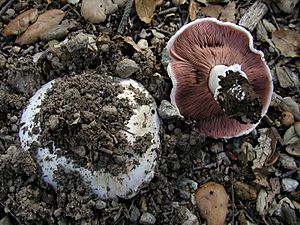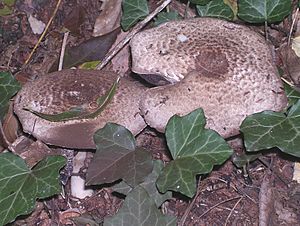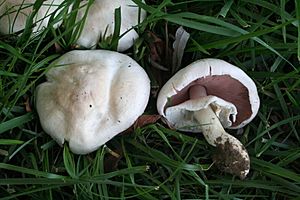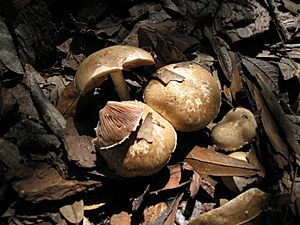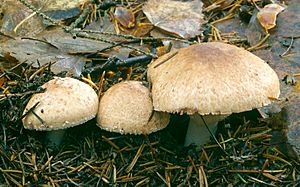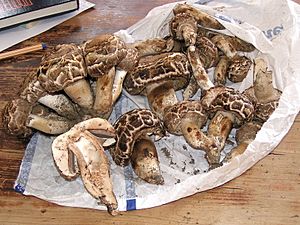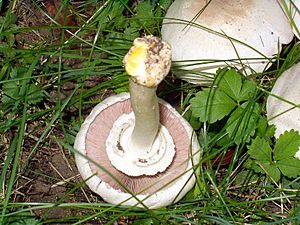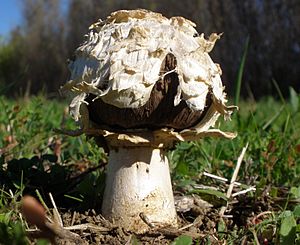Agaricus facts for kids
Quick facts for kids Agaricus |
|
|---|---|
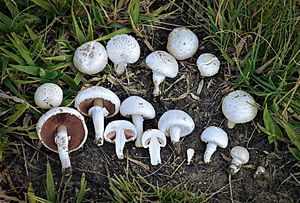 |
|
| Agaricus campestris | |
| Scientific classification |
|
| Kingdom: | Fungi |
| Division: | Basidiomycota |
| Class: | Agaricomycetes |
| Order: | Agaricales |
| Family: | Agaricaceae |
| Genus: | Agaricus L.:Fr. emend Karst. |
| Type species | |
| Agaricus campestris L.:Fr.
|
|
| Synonyms | |
|
|
Agaricus is a genus of mushrooms containing both edible and poisonous species, with possibly over 300 members worldwide. The genus includes the common ("button") mushroom (Agaricus bisporus) and the field mushroom (A. campestris), the dominant cultivated mushrooms of the West.
Members of Agaricus are characterized by having a fleshy cap or pileus, from the underside of which grow a number of radiating plates or gills on which are produced the naked spores. They are distinguished from other members of their family, Agaricaceae, by their chocolate-brown spores. Members of Agaricus also have a stem or stipe, which elevates it above the object on which the mushroom grows, or substrate, and a partial veil, which protects the developing gills and later forms a ring or annulus on the stalk.
Taxonomy
For many years, members of the genus Agaricus were given the generic name Psalliota, and this can still be seen in older books on mushrooms. All proposals to conserve Agaricus against Psalliota or vice versa have so far been considered superfluous.
Several origins of Agaricus have been proposed. It possibly originates from ancient Sarmatia Europaea, where people Agari, promontory Agarum and a river Agarus were known (all located on the northern shore of Sea of Azov, probably, near modern Berdiansk in Ukraine). Note also Greek ἀγαρικόν, "a sort of tree fungus" (There has been an Agaricon Adans. genus, treated by Donk in Persoonia 1:180.)
Dok reports Linnaeus' name is devalidated (so the proper author citation apparently is "L. per Fr., 1821") because Agaricus was not linked to Tournefort's name. Linnaeus places both Agaricus Dill. and Amanita Dill. in synonymy, but truly a replacement for Amanita Dill., which would require A. quercinus, not A. campestris be the type. This question is compounded because Fries himself used Agaricus roughly in Linnaeus' sense (which leads to issues with Amanita), and A. campestris was eventually excluded from Agaricus by Karsten and was apparently in Lepiota at the time Donk wrote this, commenting that a type conservation might become necessary.
The alternate name for the genus, Psalliota, derived from the Greek psalion/ψάλιον, "ring", was first published by Fries (1821) as trib. Psalliota. The type is Agaricus campestris (widely accepted, except by Earle, who proposed A. cretaceus). Paul Kummer (not Quélet, who merely excluded Stropharia) was the first to elevate the tribe to a genus. Psalliota was the tribe containing the type of Agaricus, so when separated, it should have caused the rest of the genus to be renamed, but this is not what happened.
Phylogenetics
The use of phylogenetic analysis to determine evolutionary relationships amongst Agaricus species has increased the understanding of this taxonomically difficult genus, although much work remains to be done to fully delineate infrageneric relationships. Prior to these analyses, the genus Agaricus, as circumscribed by Rolf Singer, was divided into 42 species grouped into five sections based on reactions of mushroom tissue to air or various chemical reagents, as well as subtle differences in mushroom morphology. Restriction fragment length polymorphism analysis demonstrated this classification scheme needed revision.
Sections
This genus is divided into several sections:
- Section Agaricus
- Section Arvense Konrad & Maubl.
- Contains 19 species in six subgroups similar to the horse mushroom, A. arvensis, it has versatile heterothallic life cycles.
- Section Xanthodermatei
- Outlined by Singer in 1948, this section includes species with various characteristics similar to the type species A. xanthodermus. The section forms a single clade based on analysis of ITS1+2.
- Section Chitonioides
- Section Sanguinolenti
- Section Spissicaules (Hainem.) Kerrigan
- Section Duploannulatae
- Based on DNA analysis of ITS1, ITS2, and 5.8S sequences, this section (also known as section Hortenses) may be divided into six distinct clades, five of which correspond to well-known species from the temperate Northern Hemisphere: A. bisporus, A. subfloccosus, A. bitorquis, A. vaporarius and A. cupressicola. The sixth clade comprises the species complex A. devoniensis.
List of species
The fungal genus Agaricus contains about 200 species worldwide.
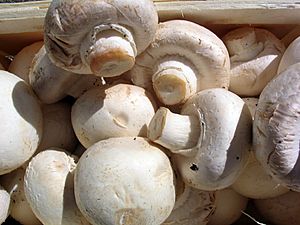
- Agaricus abruptibulbus Peck (1905) – abruptly bulbous agaricus
- Agaricus albolutescens Zeller (1938)
- Agaricus aestivalis Pilat (1951)
- Agaricus agrinferus Kerrigan & Callac – California
- Agaricus angusticystidiatus
- Agaricus annae
- Agaricus alabamensis – North America
- Agaricus albertii Bon (1988)
- Agaricus altipes Møller (edible)
- Agaricus amicosus
- Agaricus andrewii Freeman (choice edible)
- Agaricus arcticus
- Agaricus argenteus
- Agaricus argentinus
- Agaricus aridicola Geml, Geiser & Royse (2004)
- Agaricus aristocratus
- Agaricus arorae
- Agaricus arvensis – horse mushroom
- Agaricus augustus – the prince
- Agaricus aurantioviolaceus
- Agaricus benesii
- Agaricus bernardii – salt-loving mushroom
- Agaricus biannulatus Mua, L.A.Parra, Cappelli & Callac (2012) – Europe
- Agaricus bisporiticus – Asia
- Agaricus bisporus – cultivated mushroom
- Agaricus bitorquis – pavement mushroom
- Agaricus blazei
- Agaricus bohusianus L.A.Parra (2005) – Europe
- Agaricus bohusii
- Agaricus bresadolanus
- Agaricus caballeroi L.A.Parra, G.Muñoz & Callac (2014) – Spain
- Agaricus californicus
- Agaricus campbellensis
- Agaricus campestris – field mushroom, meadow mushroom (US)
- Agaricus cellaris
- Agaricus chartaceus
- Agaricus chionodermus
- Agaricus chlamydopus
- Agaricus colpeteii
- Agaricus columellatus
- Agaricus comtuliformis
- Agaricus comtulus
- Agaricus cretacellus
- Agaricus cretaceus
- Agaricus crocodilinus
- Agaricus cupreobrunneus – brown field mushroom
- Agaricus cupressophilus Kerrigan (2008) – California
- Agaricus depauperatus
- Agaricus deserticola G.Moreno, Esqueda & Lizárraga (2010) – gasteroid agaricus
- Agaricus devoniensis
- Agaricus diminutivus
- Agaricus dulcidulus – rosy wood mushroom
- Agaricus eburneocanus
- Agaricus endoxanthus
- Agaricus erthyrosarx
- Agaricus essettei (= A. silvicola)
- Agaricus excellens
- Agaricus fissuratus
- Agaricus freirei – Spain
- Agaricus fuscofibrillosus
- Agaricus fuscovelatus
- Agaricus floridanus
- Agaricus fuscopunctatus – Thailand
- Agaricus halophilus
- Agaricus hondensis
- Agaricus hortensis
- Agaricus huijsmanii Courtec. (2008)
- Agaricus inilleasper
- Agaricus impudicus
- Agaricus inapertus
- Agaricus koelerionensis
- Agaricus lacrymabunda
- Agaricus lamelliperditus
- Agaricus langei
- Agaricus lanipes
- Agaricus laskibarii
- Agaricus leucotrichus Møller (edible)
- Agaricus lilaceps – cypress agaricus
- Agaricus litoralis – coastal mushroom
- Agaricus ludovici
- Agaricus luteomaculatus
- Agaricus maclovianus
- Agaricus macrocarpus
- Agaricus macrolepis (Pilát & Pouzar) Boisselet & Courtec. (2008)
- Agaricus magni
- Agaricus maleolens
- Agaricus medio-fuscus
- Agaricus meleagris
- Agaricus menieri
- Agaricus micromegathus (edible)
- Agaricus microvolvatulus
- Agaricus minimus
- Agaricus moelleri – inky mushroom
- Agaricus murinocephalus – Thailand
- Agaricus nebularum – South America
- Agaricus niveolutescens
- Agaricus osecanus
- Agaricus pachydermus
- Agaricus pampeanus
- Agaricus parvitigrinus
- Agaricus pattersoniae – California
- Agaricus perobscurus
- Agaricus perrarus
- Agaricus phaeolepidotus
- Agaricus pilatianus
- Agaricus pilosporus
- Agaricus placomyces
- Agaricus pocillator
- Agaricus porphyrizon
- Agaricus porphyrocephalus Møller (edible)
- Agaricus praerimosus
- Agaricus pratensis
- Agaricus pseudopratensis
- Agaricus purpurellus
- Agaricus radicatus
- Agaricus romagnesii
- Agaricus rosalamellatus
- Agaricus rotalis
- Agaricus rubellus
- Agaricus rufotegulis
- Agaricus rusiophyllus
- Agaricus santacatalinensis – Brazil
- Agaricus semotus
- Agaricus silvaticus – scaly wood mushroom, blushing wood mushroom, or pinewood mushroom
- Agaricus silvicola Peck (1872) – wood mushroom
- Agaricus smithii
- Agaricus solidipes Peck, Bull (1904) (edible)
- Agaricus spissicaulis
- Agaricus stigmaticus Courtec. (2008)
- Agaricus stramineus
- Agaricus subantarcticus
- Agaricus subfloccosus
- Agaricus subperonatus
- Agaricus subrufescens (= Agaricus blazei) – almond mushroom, mushroom of the sun, God's mushroom, mushroom of life, royal sun agaricus
- Agaricus subrutilescens – wine-colored agaricus
- Agaricus subsaharianus L.A.Parra, Hama & De Kesel (2010)
- Agaricus subsubensis Kerrigan (2008) – California
- Agaricus taeniatus – China
- Agaricus tlaxcalensis Callac & G.Mata (2008) – Tlaxcala
- Agaricus urinascens
- Agaricus vaporarius
- Agaricus variegans
- Agaricus valdiviae
- Agaricus xanthodermulus
- Agaricus xanthodermus – yellow-staining mushroom
- Agaricus xantholepis
Echigoshirayukidake (Basidiomycetes-X) is also thought to be in Agaricus, either as a subspecies of Agaricus blazei or a new species.
Edibility and toxicity
The genus contains the most widely consumed and best-known mushroom today, A. bisporus, with A. campestris also being well known. A. porphyrocephalus is a choice edible, and some others are edible as well.
A notable inedible species is the yellow-staining mushroom, A. xanthodermus. One species reported from Africa, A. aurantioviolaceus, is reportedly deadly poisonous.
See also
 In Spanish: Agaricus para niños
In Spanish: Agaricus para niños


